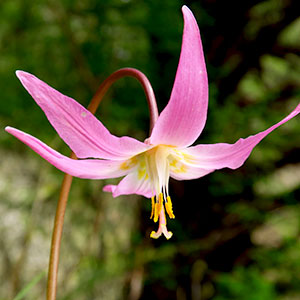Erythronium revolutum
Erythronium rostratum
coast fawn lily, mahogany fawn lily, pink fawn-lily
beak trout-lily, yellow fawnlily, yellow troutlily
narrowly ovoid, 35–50 mm, sometimes producing sessile offsets.
ovoid, 10–20 mm;
stolons 1–3, common, mostly on 1-leaved, nonflowering plants.
10–25 mm;
blade distinctly mottled with irregular streaks of brown or white, broadly lanceolate to ovate, margins entire to ± wavy.
5–18 cm;
blade green, irregularly mottled, elliptic-lanceolate to ovate or elliptic, ± flat, not glaucous, margins entire.
15–40 cm.
3–10 cm.
1–3-flowered.
1-flowered.
tepals uniformly clear violet-pink at anthesis, with yellow banding at base, lanceolate to narrowly elliptic, 25–40 mm, inner with small auricles at base;
stamens ± appressed to style, 12–22 mm;
filaments white to pink (darkening with age), flattened, ± lanceolate, 2–3 mm wide;
anthers bright yellow;
style white to pink, 12–18 mm;
stigma with slender recurved lobes 4–6 mm.
held erect at anthesis;
tepals yellow, tinged red-purple or orange abaxially, mostly spreading at anthesis, lanceolate, 20–34 mm, inner with conspicuous, well-developed auricles almost encircling opposing filaments;
stamens 13–17 mm;
filaments yellow, lanceolate;
anthers yellow;
pollen yellow;
style persistent, greenish yellow, swollen distally into stigma, tapering gradually proximally to ovary, forming beak on capsule, 8–11 mm;
stigma lobes erect, short, 1 mm.
oblong to obovoid, 3–6 cm.
held erect at maturity on upward-curving peduncle, ellipsoid to ellipsoid-obovoid, 15–25 mm (excluding beak), apex long-beaked.
= 24.
Erythronium revolutum
Erythronium rostratum
Erythronium rostratum is found mostly on either side of the Mississippi River embayment, but rarely within it. It often forms extensive colonies where nonflowering, 1-leaved plants far outnumber flowering ones. This is the only species of Erythronium with erect rather than nodding flowers. Some plants at the western limits of the range are triploids (B. L. Carr 1986).
(Discussion copyrighted by Flora of North America; reprinted with permission.)
- Local floras:
BC,
CA,
OR,
WA
- Local Web sites:
CalFlora,
CalPhotos,
Flora NW,
PNW Herbaria,
Turner Photog.
WildflowerSearch
iNaturalist (observations)
USDA Plants Database
- LBJ Wildflower Center
- SEINet
- Plants of the World Online
- Encyclopedia of Life
- Wikipedia
- Google Image Search


